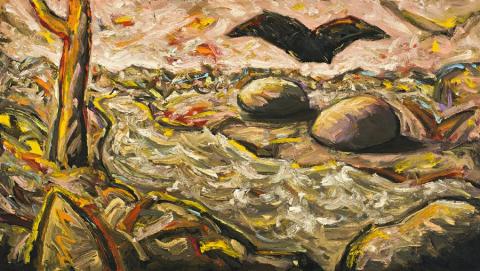THE RIVER, 1985
PETER BOOTH
oil on canvas
121.5 x 213.0 cm
inscribed on stretcher verso: BOOTH CDS#1723
CDS Gallery, New York (label attached verso)
Centro Cultural Arte Contemporaneo, Mexico (label attached verso)
Christie's, New York, 1 July 2008, lot 489
Private collection, Sydney
Peter Booth, CDS Gallery, New York, 1986
Although it was his large monochromatic abstract works which first brought Booth to international attention during the 1970s, today it is his immensely vivid and painterly figuration for which he is most renowned. Drawing upon epic legends of the past and prophecies for an imagined future, these dramatic, poetic images of the human spirit poignantly explore fundamental human emotions and anxieties, issues of spiritual turmoil, social alienation and the devolution of civilisation. Thus framed within a world both imagined and observed, Booth's vision transcends the immediate or particular to acquire a universality comparable to the musings of his greatest artistic predecessors, including Goya, Blake and Shakespeare.
Charged with emotion and symbolic meaning, The River 1985 belongs to a transitional phase in Booth's oeuvre between his celebrated 'apocalyptic' paintings executed from 1977 to 1982, and the quiet chill of the snow paintings which he commenced during the winter of 1989. In the iconic Painting 1977 (Man on the road with white dog) from the National Gallery of Victoria, the displaced everyman-prophet is forced to begin a journey in a post holocaust (nuclear) world as a consequence of man's self-destructive violence and greed. The subsequent group of paintings charts his descent into Hell and the emergence of a race of mutants, while the noticeably desolate snow paintings of the 1980s and frozen landscapes of the 1990s herald the end of man's cycle of ambition - the white blanket of snow or sleet muffling the screams of the decay of civilisation (see lot 3). Thus, Booth presents a Blakean devolution from civilisation towards tribalism and eventually extinction - a journey that has its antecedents in Milton's epic sequence of poems, Paradise Lost (1667) to Paradise Regained (1671).
Powerfully evoking the aftermath of some terrible disaster, vividly captured with menacing abstract forms and agitated, heavily applied brushwork, The River 1985 is a dramatic image of intense anxiety encapsulating well Booth's landscapes from this period. While undoubtedly infused with memories of his childhood in the blackened industrial landscape of Sheffield, perhaps more fundamentally, the series resonates with the artist's experience of the prehistoric local terrain - and particularly, of working in the bushfire-ravaged areas of Victoria during 1983. (Indeed, the closely-related Desert 1985 in the collection of the Museum of Modern Art, New York, has been described by Booth as his nearest approximation to a specifically 'Australian' landscape in terms of light and desolation.1) A metaphor for the artist's subjective relationship to the natural world, such scenes not only blur the boundaries between the realm of the subconscious and that of observed reality, but notably merge figuration and abstraction, with elements of the natural environment acting as potent signs which erupt from the canvas with stunning emotional force. Accordingly while the winding river here links earth and sky compositionally, it also resists gravity with an ambiguous, pulsating life suggesting the possibility of delivery from chaos - thus poignantly highlighting Booth's abiding assertion that even the bleakest of his landscapes 'is not without hope!'2
1. Smith, J., Peter Booth: Human / Nature, National Gallery of Victoria, Melbourne, 2003, p. 14
2. Booth cited ibid., p. 9
VERONICA ANGELATOS
